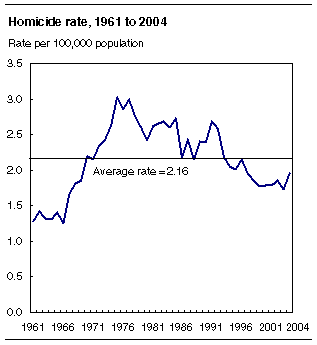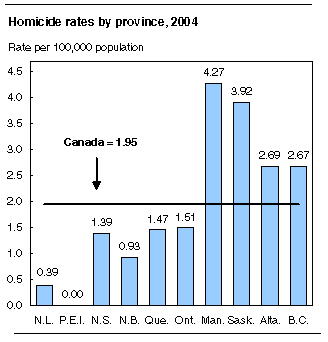
















 |
|
 |                |
Information identified as archived is provided for reference, research or recordkeeping purposes. It is not subject to the Government of Canada Web Standards and has not been altered or updated since it was archived. Please "contact us" to request a format other than those available.

|

Thursday, October 6, 2005 Homicides2004Canada's homicide rate jumped in 2004 after reaching a 30-year low in 2003. Five of the nation's largest census metropolitan areas accounted for the majority of last year's increase. Police services reported 622 homicides last year, 73 more than in 2003. Together, Winnipeg, Edmonton, Vancouver, Calgary and Montréal accounted for three-quarters of this increase. 
The 2004 rate of 1.95 homicides for every 100,000 population was 12% higher than in 2003 and 3% higher than the average over the previous decade. Canada's homicide rate has generally been declining since peaking at just over 3.0 homicides for every 100,000 population in the mid-1970s. While homicide is often thought of as a major urban phenomena, murder rates outside census metropolitan areas (CMAs) are typically as high or higher than those within CMA boundaries, and this was the case in 2004. The combined rate for all CMAs last year was 1.91 homicides per 100,000 population, compared to 2.01 for all areas outside these CMAs.
The study, an in-depth examination of homicide, also showed that the rate of homicides committed with a firearm increased slightly for the second consecutive year. The number of spousal homicides declined for the third year in a row in 2004, although all other categories of family homicide increased. Police reported 18 prostitutes killed, 11 of which were directly related to their profession. In addition, there were 81 victims killed as a direct result of their involvement in other illegal activities such as drug trafficking and gang violence. Firearm homicides increase slightlyThere were 172 homicides committed with a firearm in 2004, 11 more than in 2003 and 20 more than in 2002. However, the 2004 total was still slightly below the average of 176 homicides involving firearms over the past decade. During the past 10 years, the proportion of homicides involving a firearm has remained fairly stable, ranging from 26% to 34%. In 2004, the proportion was 28%. In contrast, in the United States, two-thirds of all homicide victims were killed with a firearm in 2003, more than double the proportion seen in Canada. Over the past decade, the highest rates of firearm homicides have been reported in British Columbia and Quebec. However, in 2004, Manitoba recorded 13 homicides committed with a firearm, giving it the highest provincial rate for that year. Beginning in 2001, handguns have consistently accounted for about two-thirds of all firearm-related homicides in Canada. Last year was no exception, as 65% of firearm homicides were committed with a handgun. Over the years, the primary method used to commit homicide has varied between stabbings and shootings. With 63 more than in 2003, the most common method used last year was stabbings, accounting for one-third of all homicides. Beatings accounted for 22% and strangulation/suffocation for a further 10%. Third decline in a row in spousal homicide rateAs in previous years, most homicides in 2004 were committed by someone known to the victim. Among solved homicides, half were committed by an acquaintance, one-third by a family member and 15% by a stranger. Spousal homicides are those involving people in legal marriages, those who are separated or divorced from such unions, and those in common-law relationships. The national spousal homicide rate has generally been declining since the mid-1970s. Police reported that 74 spouses were killed in 2004, down from 78 the year before, and the third consecutive annual decline. Even so, they still accounted for about one in six solved homicides and almost one-half of all family homicides. Women were much more likely to be killed by their spouse than men. In 2004, the spousal homicide rate against women was five times higher than the corresponding rate for men. Those in common-law relationships were more at-risk than those living in legally married unions. In 2004, the homicide rate against persons living in common-law relationships was almost five times higher than the rate for those living in legal marriages. Of the 62 female victims of spousal homicide, 27 women were killed by their legally-married husband, 20 by a common-law husband and 15 by a separated or divorced husband. Of the 12 male victims, 3 were killed by their legally-married wife, 8 by their common-law wife and 1 by a separated or divorced wife. Homicides involving relationships with intimate partners doubled from 11 in 2003 to 22 in 2004. These included homicides committed by current or former boyfriends, girlfriends and extra-marital lovers. Among solved homicides involving victims aged 15 and older, one-half of all women were killed by someone with whom they had had an intimate relationship at some point, either through marriage or dating. The comparative figure for men was 8%. Men were far more likely to be killed by an acquaintance or a stranger. All categories of non-spousal family homicides increased in 2004. There were 36 children killed by their parent, 17 parents killed by their child, 11 victims killed by a sibling and 22 other family-related homicides. Decline in homicides committed by youthDespite the overall increase in homicides in 2004, the number of youths aged 12 to 17 accused of homicide fell from 57 in 2003 to 40 in 2004. The youth accused homicide rate was at its second lowest point in more than 30 years. As was the case historically, youth were more likely than adults to kill other youth and young adults. Among solved homicides committed by youth in 2004, two-thirds of victims were aged 14 to 24 compared with 17% of homicides committed by adults. Mental illness a factor in many homicidesA new detailed profile of the relationship, motivation and location of all 2004 homicides revealed that 70 victims were killed by someone that police believed was suffering from mental illness. The majority of these homicides were committed against family members. There were 33 victims killed during a robbery, two-thirds of which occurred in the victim's residence. Half of those victims killed in their own home were over the age of 60. In addition, over half of victims and almost three-quarters of accused persons had consumed alcohol and/or drugs at the time of the homicide. There were also 20 victims killed as a result of an argument originating in a bar. Homicide rates highest in the WestThe 2004 national increase in homicides was mainly due to an increase of 22 homicides in Alberta, 18 in British Columbia, and 12 in Quebec. 
The highest homicide rates among the provinces were reported in Manitoba and Saskatchewan, followed by Alberta and British Columbia. Quebec and Ontario's rates were below the national average, while the lowest rates were found in Prince Edward Island and Newfoundland and Labrador. Manitoba's rate of 4.27 homicides per 100,000 population was the second highest in that province since data were first collected in 1961. With almost double the number of homicides in 2004 from the previous year, Winnipeg recorded the highest rate, 4.89, among the nine CMAs with populations over 500,000. Regina had the highest rate of all CMAs at 4.98. Available on CANSIM: tables 253-0001 to 253-0006. Definitions, data sources and methods: survey number 3315. The publication Juristat: Homicide in Canada, 2004, Vol. 25, no. 6 (85-002-XIE, $9/$75; 85-002-XPE, $11/$100) is now available. For further information, or to enquire about the concepts, methods or data quality of this release, contact Information and Client Services (1-800-387-2231; 613-951-9023), Canadian Centre for Justice Statistics.
| ||||||||||||||||||||||||||||||||||||||||||||||||||||||||||||||||||||||||||||||||||||||||||||||||||||||||||||||||||||||||||||||||||||||||||||||||||||||||||||||||||||||||||||||||||||||||||||||||||||||||||||||||||||||||||||||||||||||||||||||||||||||||||||||||||||||||||||||||||||||||||||||||||||||||||||||||||||||||||||||||||||||||||||||||||||||||||||||||||||||||||||||||||||||||||||||||||||||||||||||||||||||||||||||||||||||||||||||||||||||||||||||||||||||||||||||||||||||||||||||||||||||||||||||||||||||||||||||||||||||
|
|
|